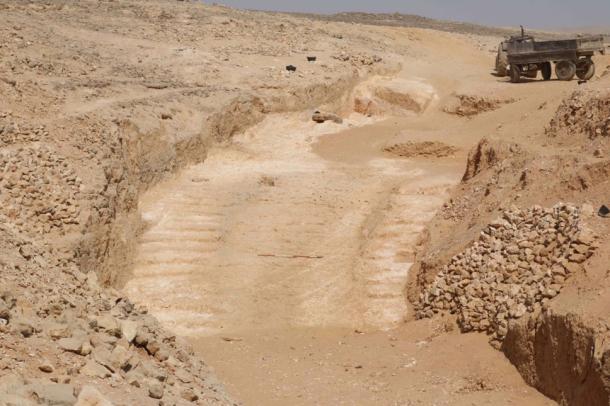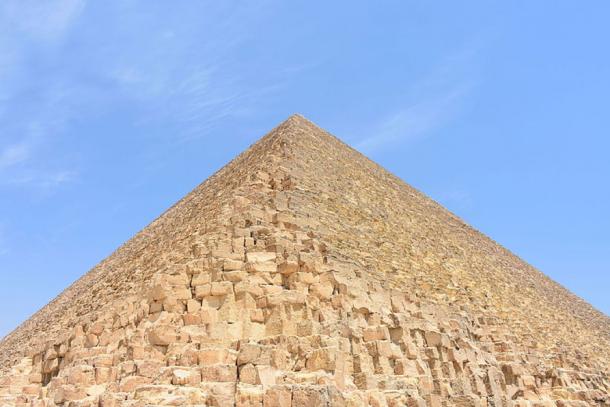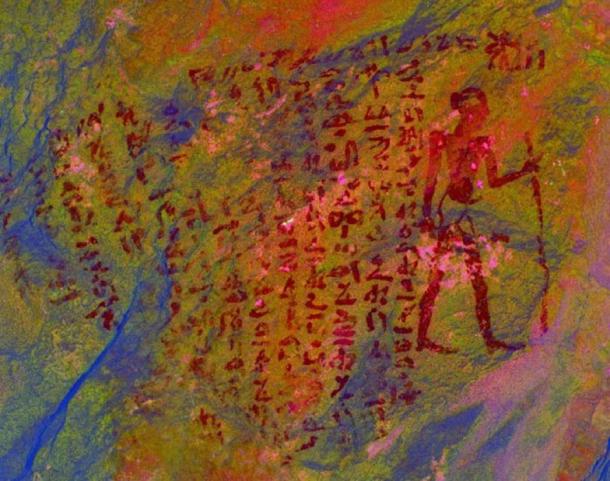Archaeologists Say They’ve Solved Mystery of How Pyramids were Built After Unearthing 4,500-Year-Old Ramp
Has the riddle of how the ancient Egyptians built the pyramids finally been solved? A multi-national team of experts say yes, after they unearthed an ancient ramp, which they say was used to haul giant blocks into place.
Despite centuries of research into the pyramids of Giza, there has still been no definitive explanation as to how the ancient Egyptians cut, transported, and assembled millions of limestone and granite blocks, each weighing an average of 2.3 metric tons. “For the construction of the pyramids, there is no single theory that is 100% proven or checked; They are all theories and hypotheses,” said Hany Helal, Vice President of the Heritage Innovation Preservation institute. But many have speculated that ramps played a very important role in the construction of pyramids such as the three world-famous pyramids at Giza.

This 4,500-year-old ramp was discovered at Hatnub, an ancient quarry in the Eastern Desert of Egypt. Two staircases with numerous postholes are located next to the ramp. An alabaster block would have been placed on a sled, which was tied by ropes to the wooden poles. (Yannis Gourdon/Ifao)
A combined team of archaeologists from the French Institute for Oriental Archaeology based in Cairo and the University of Liverpool from the UK were excavating at the Hatnub alabaster quarry, which is near Luxor. It was here, according to Science Alert, that they found a ‘4,500-year-old ramp’ that was apparently used to move blocks of alabaster cut from the steep slopes of the quarry. This type of stone was used in the construction of tombs and for paving the floors of pyramids and temples.
- The Great Pyramid of Giza: A Modern View on Ancient Knowledge, Earth and Water – Part I
- Unraveling the Mystery of the Great Pyramid Air-Shafts
- Analysis Begins on Cosmic Particles in the Egyptian Bent Pyramid – Will This Help Explain How the Pyramids Were Built?
The System for Moving Huge Alabaster Blocks
The archaeologists believe that they have discovered the Egyptian system for moving the large building blocks based on their investigations in the quarry. This system involved the construction of a large ramp, which was lined by flights of stairs on each side where large wooden posts were fixed. The co-director of the excavation told Live Science that the archaeologists believe that a ‘sled carried a stone block’ and was tied to the wooden posts on the stairs. By pulling on the ropes, workmen could maneuver the stone down the ramp. The system, using wooden poles, ropes, and gravity, allowed huge blocks to be taken out of the quarry.
Fox News reports that ‘this kind of system has never been discovered anywhere else" . The Anglo-French team, with the support of the Egyptian Ministry of Antiquities, investigated the tool marks and linked them to some inscriptions found in the quarry. The archaeologists believe that the ramp dates back to the reign of the Pharaoh Khufu (died 2566 BC) who constructed the Great Pyramid at Giza.

Looking up at the Great Pyramid of Giza from the base of the southeast corner. (MusikAnimal/CC BY SA 4.0)
Can Researchers Finally Agree How the Pyramids Were Built?
The team believes that they have finally shown how the Egyptians moved massive stones. This is because they presume that the method for moving alabaster was similar to that used to move other stone blocks. The main stone used in the construction of the pyramids was limestone, and according to Live Science, the ‘ramp system could contain some vital clues’ as to how the Egyptians moved stone and how they were able to place huge blocks on the side of the pyramid.
- The Hidden Message in Khafre’s Pyramid: What Were the Builders Trying to Tell Us?
- Has the Function of the Great Pyramid of Giza Finally Come to Light?
- 5 Pyramids of the Ancient World that You May Not Have Heard About
This was not the only important find at the alabaster quarry. During their excavation, the experts found a large number of inscriptions marking the visits of Pharaohs to the quarry, indicating its importance in royal building projects. The team has also uncovered four stone slabs (stele) with some inscriptions that are illegible. They also found some of the huts that once sheltered the quarry workers. There are conservation efforts being undertaken to protect the inscriptions and the structures.

During their excavation, the experts found a large number of inscriptions marking the visits of Pharaohs to the quarry, indicating its importance in royal building projects. (Ministry of Antiquities)
The Secretary-General of the Egyptian Ministry of Antiquities says the discovery is one of the first to show how the Pharaohs’ workmen moved heavy blocks. It also confirms the importance of ramps in the construction of the pyramids. Most significant of all, it provides evidence on the advanced engineering skills and knowledge of ancient Egypt some 4,500 years ago, when most of the world was still in the Stone Age.
Top image: How were the pyramids built? The discovery of a quarry ramp may finally provide a consensus on this debate. Source: Fotolia
By Ed Whelan




















Comments
I thought it had long been established that these pyramids were fabricated with concrete. The concept of moving large blocks of stone is obsolete. The discovery, as I recall, was made by a Texas A&M archeologist who found period era trash like chicken bones in the stone blocks. Sort of like finding a soda can in the stone block. I would still need a ramp for my wheelbarrow.
Finding a ramp means nothing unless it is determined how to move "limestone and granite blocks, each weighing an average of 2.3 metric tons." This is just used by archaeo's because it goes along with their predetermined belief system.
Okay, okay, let me get this straight. So... They're saying that the ancient Egyptians sonehow defyied gravity by using a ramp that they say was used to LOWER big stone blocks? And that this somehow was used to build the pyramids? Give me a break. You still have the massive problem of building an enormous ramp to drag stone block UP to the Pyramids, now even worse since they couldn't even just use rubble to make them. This is simply a method of safely getting alabaster down out of the quarry. Also, would love to know how they came upon the date for this. Was it inscribed? Otherwise, not sure how they can say how old it is with confidence. I think this is really a matter of them trying to make a name for themselves by blowing their find out of proportion.
So how many men were required to move these several ton blocks from the bottom to the top and how long did it take?What did they do with the dead bodies of those Pharos (sorry) that died before their pyramid was completed? Did they bury the within the pyramid as it was being built? So many questions!